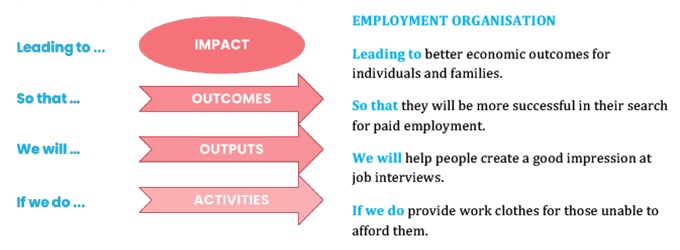strategy-risk
The Secret Ingredient to Great Not-for-Profit Strategy
Published: August 2, 2023
Read Time: 6 minutes

Co-authored by Felicity Green and Elena Mogilevski
Strategic planning for the not-for-profit sector is vastly different from planning for the private sector. Many board directors of not-for-profit organisations are volunteers with a background in corporate or private enterprise, and the difference between strategies in the sectors can sometimes be challenging to navigate.
It is imperative to understand, however, that the north star to guide social sector strategy development is not simply shareholder value, but rather an often complex combination of outcomes that drive positive impact for those that the organisation exists to serve. Accordingly, the way to approach strategic planning in the not-for-profit sector cannot be a carbon copy of processes and frameworks used in the private sector. Having assisted hundreds of not-for-profit organisations to develop impact-led strategy, we argue that a critical component to strategy formulation for this sector is to ensure that there is a clearly articulated theory of change.
Great strategy is often developed through an iterative, emergent process. Crystalising your hypothesis for change at the beginning, through a theory of change, is an incredibly useful umbrella to guide the entire process.
At Ensemble Strategy, we have developed a bespoke framework called SENSE (because it’s all about sense-making!) to develop not-for-profit strategy. A summary of the stages are as follows:
1. Scope
Understand what success looks like, gather background desk-based information to review and conduct research into the competitive and comparative landscapes.
2. Engage
Listen before making decisions. Interviews, workshops, focus groups, surveys etc. are the mechanisms by which you can probe into perspectives as to what value to you provide to whom and why you? Here is the opportune time to develop a Theory of Change if you do not already have one.
3. Navigate
This phase focuses on drawing patterns, synthesising the insights to date into meaningful communications for the board.
4. Shape
The crux of strategy formulation occurs when directors to come together and contest the critical components of the strategy, such as vision/ mission/ purpose, whether the strategy is one of growth or consolidation, and what the key areas of focus for the coming period should be.
5. Execute
This final phase is where the draft strategic direction is tested against different scenarios. The details are fleshed out, and measures (which should be guided by, and align to your theory of change) are developed, so that the board can confidently govern strategically as the plan is enacted.
Organisational strategy and impact measurement frameworks underpinned by a theory of change go hand in hand. Applying a theory of change methodology to test concepts in the strategy can ensure that all organisational activities are focused on creation of desired impact.
It is worth noting that there is an increasing interest by funders including government and philanthropy in measuring impact their investments are creating. It is no longer enough to report only on the number of people your organisation has worked with, the number of trees planted, or workshops delivered. Funders are increasingly requesting to see the change your organisation is creating for your beneficiaries and how you document the evidence that this change has occurred. Organisations that are not deliberate in articulating and measuring their impact are at an increasing risk of being less competitive in their search for funding.
Now that we’ve made the case for a theory of change, let’s demystify what it actually is, namely, a tool that is commonly used by organisations to comprehensively describe and illustrate how and why a desired change is expected to happen in a particular context. There are many versions of this tool and the terminology used could sometimes be confusing. In simple terms, a theory of change articulates the “missing middle” between what your organisation does and how your work contributes to the solution of the problem you are seeking to address.
Ideally a theory of change is a one-page visual diagram which details your programs and activities, outputs of your activities, outcomes you are hoping to achieve from your activities and the ultimate impact you are hoping to create. Below is a simplified example of how an organisation that is seeking to improve employment outcomes for disadvantaged people might structure their theory of change.

The main challenge most organisations experience in developing their theory of change is differentiating between their outputs and outcomes. Distributing work attire to an individual might not change anything in that person’s life. The outcomes we would be looking for in this example is that the beneficiaries feel more confident and are able to attend an interview because they have appropriate clothes. The desired change we would want to measure is whether participants have moved from a place where they are not going for jobs at all to attending interviews and hopefully getting a job.
Note from this example that what is typically measured is outcomes rather than impact. This is done in recognition of the fact that it is extremely hard to create credible linkages between your activities to something as far reaching as better economic outcomes for individuals and families. Many factors, including education, health and broader economic environment will play a role, most of those factors are likely to be beyond our sphere of control. Having said that, what our imaginary organisation can measure is how many people they assisted, how many of those got a job, whether their income and wellbeing has increased. In a nutshell, a theory of change is about creating a credible story about why your interventions work and collecting evidence that they do.
If you are a director of a not-for-profit organisation, we encourage you to:
-
Ask whether your organisation has a current theory of change. These are great induction tools for new directors, and a good source to keep returning to in board conversations to ensure that discussions are strategic.
-
When developing your next strategic plan, revisit the theory of change - is it still applicable, does it need to be updated or amended considering changes in the internal or external environment?
-
Ensure the theory of change is meaningfully integrated into your strategy, and not just sitting aside as a standalone artefact e.g., are the measures of success that board members are tracking against the strategy aligned with the theory of change?
One of the great privileges of being a board member is the custodial role of the organisation’s strategy. Integrating theory of change into your strategic planning will assist you to undertake this important role, and ultimately help to create a safer, fairer, more sustainable world. Because that’s the whole point of not-for-profit strategy in the end.
This article was originally published in the Better Boards Conference Magazine 2023
Further Resources
What to Look for During Customer-Centric Transformation
Unlocking the Power of Strategic Thinking and Planning
The Role of the Board in Not-for-Profit Strategic Planning
Share this Article
Recommended Reading
Recommended Viewing
Author
-
Co-founder and Director
Ensemble Strategy
- About
-
Felicity has dedicated her career to helping bold leaders create strategies for a more equitable and sustainable world. Springboarding from corporate management consulting, Felicity co-founded social impact strategy firm Spark Strategy, where she recently held the CEO position, before once again scratching the entrepreneurial itch by co-founding Ensemble Strategy. With an MBA from Peking University, multiple Not for Profit Board positions and recognition as a finalist in the Telstra Business Woman of the Year Awards, she has a proven track record of innovative strategic thinking that drives tangible impact. An avid public speaker (e.g. Better Boards, Asia Pacific Impact Investment Summit), she’s also made guest appearances on leading podcasts (e.g. Humans of Purpose, Good Will Hunters) and is published widely (e.g. Pro Bono, Third Sector). A super networker, Felicity is a key advocate of the B Corp movement and founding member of Women in Impact, the Impact Circle and League of Intrapreneurs.
Found this article useful or informative?
Join 5,000+ not-for-profit & for-purpose directors receiving the latest insights on governance and leadership.
Receive a free e-book on improving your board decisions when you subscribe.
Unsubscribe anytime. We care about your privacy - read our Privacy Policy .










